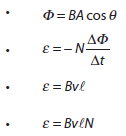|
Nature of science:
Experimentation: In 1831 Michael Faraday, using primitive equipment, observed a minute pulse of current in one coil of wire only when the current in a second coil of wire was switched on or off but nothing while a constant current was established. Faraday’s observation of these small transient currents led him to perform experiments that led to his law of electromagnetic induction. (1.8)
|
Understandings:
- Emf
- Magnetic flux and magnetic flux linkage
- Faraday’s law of induction
- Lenz’s law
Applications and skills:
- Describing the production of an induced emf by a changing magnetic flux and within a uniform magnetic field
- Solving problems involving magnetic flux, magnetic flux linkage and Faraday’s law
- Explaining Lenz’s law through the conservation of energy
|
Theory of knowledge:
- Terminology used in electromagnetic field theory is extensive and can confuse people who are not directly involved. What effect can lack of clarity in terminology have on communicating scientific concepts to the public?
Utilization:
- Applications of electromagnetic induction can be found in many places including transformers, electromagnetic braking, geophones used in seismology, and metal detectors
Aims:
- Aim 2: the simple principles of electromagnetic induction are a powerful aspect of the physicist’s or technologist’s armoury when designing systems that transfer energy from one form to another
|

